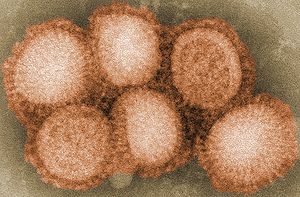An antibody that recognizes all strains of influenza A could be a universal vaccine blueprint.
Scientists have found an antibody that inactivates all influenza A subtypes. The antibody binding site, tucked away in a stable region of the virus, might form the first lasting vaccine against flu.
The influenza virus constantly mutates, forcing scientists to play catch-up and produce a new seasonal vaccine each year. But Antonio Lanzavecchia, an immunologist at the Institute for Research in Biomedicine in Bellinzona, Switzerland, and an author on the new study, says that observing the human immune response to influenza convinced him that it would be possible to design a vaccine that prevails over mutation.
“During the 2009 H1N1 pandemic, we found some people with antibodies to multiple viral subtypes,” says Lanzavecchia. Antibodies, which are produced by white blood cells called B cells, bind to specific target sites, inactivating viruses or flagging them for destruction by other immune cells.
Immune reaction
To test the cross-reactivity of influenza antibodies, the team screened B cells from eight human donors who had been infected with or immunized against different influenza strains. They took the B cells early in the immune response, when the repertoire of antibodies they secrete is at its most diverse.
After looking at 104,000 B cells, they hit the jackpot. “Our FI6 antibody is the first one ever found that reacts to all 16 of the influenza A subtypes,” says Lanzavecchia.
The finding, published today in Science1, follows other reports of broadly reactive influenza antibodies, but these could only bind to either group 1 viruses, such as the H1N1 ‘swine flu’ and the avian influenza H5N12, or group 2 viruses3, which include the seasonal H3N2 strains.
“Finding antibodies to all strains of one group was exciting,” says immunologist Patrick Wilson from the University of Chicago, Illinois, who was not involved with the study, “but getting one to both groups is stunning.”
The antibody itself is not a vaccine, but it could be an instruction manual for making one. The scientists say that a small protein mimicking the part of the virus bound by the FI6 antibody might cajole the immune system into making similarly cross-reactive antibodies.









